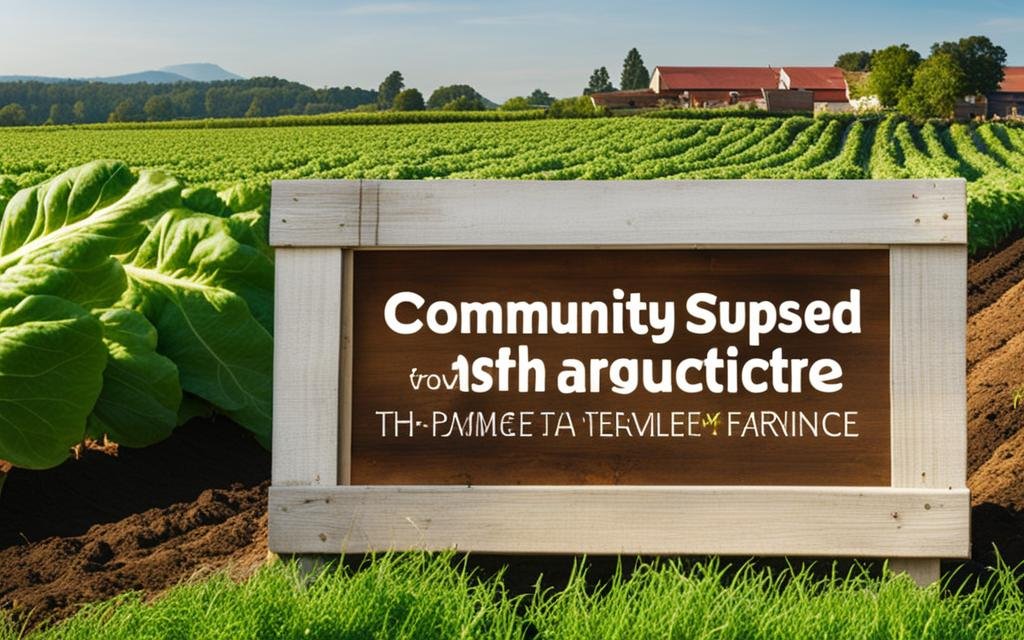Community-Supported Agriculture (CSA) offers a unique way to access fresh, locally grown produce while staying within your budget. By becoming a CSA member, you not only support local farmers but also enjoy the health benefits of consuming sustainably produced food. Let’s explore the advantages of joining a CSA and how it can help you enjoy fresh produce without breaking the bank.
Key Takeaways:
- CSA provides a direct connection between farmers and consumers, ensuring access to fresh produce.
- By buying shares in advance, CSA members share in the risk of production and support farmers financially.
- CSA membership offers a variety of freshly picked vegetables and other products like fruits, herbs, meats, and dairy.
- CSA encourages sustainable farming practices and promotes the consumption of locally grown, organic food.
- Joining a CSA can be cost-effective compared to purchasing produce from traditional supermarkets.
What is Community Supported Agriculture?
Community Supported Agriculture (CSA) is a popular model that allows consumers to buy shares of a farm’s harvest in advance. By participating in a CSA, you are supporting local farmers and gaining access to a variety of freshly picked vegetables, usually organic. This model promotes sustainable farming practices and provides a direct connection between consumers and the food they consume.
CSA membership typically involves paying an annual fee, which can range from $400 to $700. In return, you receive a weekly or bi-weekly share of the farm’s produce, ensuring a steady supply of fresh and nutritious food throughout the growing season. Some CSAs even offer additional products like fruits, herbs, meats, eggs, dairy, and flowers. By joining a CSA, you can enjoy the benefits of eating healthy, sustainably grown food while supporting local agriculture.
The CSA model originated in Japan in the 1960s and has since gained popularity worldwide, including in the United States. It has become a prominent alternative to traditional supermarket shopping, allowing consumers to have a closer connection to the land and the farmers who cultivate it. When you participate in a CSA, you not only receive high-quality, organic produce, but you also contribute to the growth of a more sustainable and environmentally friendly food system.

The Benefits of Community Supported Agriculture
- Access to fresh, organic produce
- Support for local farmers and the local economy
- Increased knowledge and awareness of where your food comes from
- Promotion of sustainable farming practices
- Opportunity to build community and connect with like-minded individuals
How to Get Started with a CSA
Starting a Community Supported Agriculture (CSA) is an exciting endeavor that allows you to connect with your local community and support sustainable farming practices. Here are some steps to help you get started:
1. Meet Potential Members
Begin by reaching out to friends, neighbors, and colleagues who may be interested in joining your CSA. Host a community meeting to explain the concept of CSA and gauge interest. This initial meeting will help you identify potential members and understand their needs and preferences.
2. Establish a Core Group
Form a core group of individuals who are committed to launching the CSA. This group will be responsible for making key decisions, such as finding a local farmer to partner with, setting up distribution logistics, and promoting the CSA to the wider community. Regular meetings and effective communication will be crucial to keep the CSA running smoothly.
3. Develop a Business Plan and Budget
Create a comprehensive business plan that outlines your goals, strategies, and financial projections. Consider expenses such as land rental, seeds, labor, packaging materials, and marketing costs. It’s also important to determine how many shares you aim to sell and at what price point. This will help you calculate your revenue and ensure the financial sustainability of your CSA.
Decide on the share price for your CSA based on your budget and the local market. Consider factors such as the size of the share, the number of weeks in the CSA season, and the cost of production. Provide flexibility in payment options, such as offering installment plans or accepting electronic payments, to accommodate different financial situations and increase accessibility for potential members.

One of the key considerations when joining a Community Supported Agriculture (CSA) program is determining the share price and payment options. The share price refers to the cost that members pay for a season’s worth of produce, while payment options dictate how and when payments are made. In this section, we will explore the different factors that influence share prices and payment options in CSAs.
Share prices can vary across CSAs, depending on factors such as the amount of produce distributed, the length of the CSA season, and the local market conditions. In general, a full share provides a weekly supply of fresh produce for a typical family, while a half share offers a smaller portion suitable for individuals or smaller households. While full share prices typically range from $400 to $700 per year, half shares are usually priced at a higher rate than half the cost of a full share.
Payment Options
CSAs typically offer different payment options to accommodate the financial flexibility of their members. One common option is to require full payment at the beginning of the season, providing farmers with the necessary funds to cover their upfront costs. However, some CSAs also provide payment plans to make membership accessible to individuals with limited financial resources. These plans allow members to pay in installments over the course of the season, helping to spread out the financial commitment.
By offering various share prices and payment options, CSAs aim to make their programs more inclusive and accessible to a wider range of individuals. The pricing and payment structures also support farmers by providing them with financial stability and allowing them to plan their production and resource allocation effectively. Ultimately, the goal is to create a mutually beneficial relationship in which members receive high-quality produce at a fair price while supporting local agriculture.
Retaining Members and Member Feedback
Retaining members in a Community Supported Agriculture (CSA) program is crucial for the long-term success and sustainability of the farm. While many CSAs experience a high turnover rate, losing between 25-70% of their members each season, there are strategies that can be implemented to boost member retention. By creating a sense of community and providing ongoing member education, CSA farms can enhance the member experience and encourage continued participation.
Strategies for Retaining Members:
- Organize communal workdays and social events: By offering opportunities for members to come together and engage in farm activities or socialize, CSA farms can foster a sense of belonging and community among members.
- Provide member education: Educating members about seasonal eating, sustainable farming practices, and the importance of supporting local agriculture can deepen their connection to the farm and the CSA model.
- Offer additional resources: Sharing recipes, newsletters, and other resources that help members make the most of their CSA shares can enhance their overall experience and increase satisfaction.
Feedback from CSA members is invaluable in improving future seasons and planning crops. End-of-the-year surveys can provide valuable insights into member preferences, satisfaction levels, and areas for improvement. By actively seeking and implementing member feedback, CSA farms can continuously refine their offerings and ensure member expectations are met.

Overall, retaining members in a CSA program requires the cultivation of a strong community, ongoing member education, and a commitment to meeting member needs. By implementing these strategies and actively engaging with members, CSA farms can build loyalty, improve member satisfaction, and contribute to the long-term success of their farm.
Pros and Cons of Joining a CSA
Joining a Community-Supported Agriculture (CSA) program has its share of pros and cons. Before committing to a CSA, it’s important to consider the following factors:
Commitment:
Joining a CSA requires a commitment to consume the weekly share of produce. While this can be a great way to incorporate fresh, farm-to-table food into your diet, it may not be suitable for individuals who frequently eat out or have a busy lifestyle. Additionally, some CSAs have a no-refund policy for missed weeks, so it’s essential to be prepared to consume the entire share each week.
Farm-to-Table Experience:
One of the significant advantages of joining a CSA is the opportunity to enjoy locally grown, fresh produce. CSA members have the satisfaction of knowing where their food comes from and how it was grown, fostering a deeper connection to the land and the farmers who produce their food. This farm-to-table experience can enhance the overall enjoyment and appreciation of the meals you prepare.
Cost:
Joining a CSA can be a cost-effective way to access high-quality, organic produce. While the upfront payment for a CSA membership may seem steep, it often translates to significant savings compared to regularly shopping at farmers’ markets or purchasing organic produce from supermarkets. However, it’s essential to consider your budget and assess whether the cost of a CSA membership aligns with your financial goals and priorities.
By thoroughly considering the commitment, farm-to-table experience, and cost, you can make an informed decision about whether joining a CSA is the right choice for you. Keep in mind that CSA programs vary, so it’s important to research and select a CSA that aligns with your preferences and values.

Conclusion
Community Supported Agriculture (CSA) offers numerous benefits for individuals looking to access fresh, sustainably produced food while supporting local farmers. By joining a CSA, you not only receive a variety of high-quality, farm-to-table produce but also play a vital role in fostering a sense of community and supporting the local economy.
One of the primary benefits of CSA is the opportunity to enjoy fresh, locally grown food. With CSA, you have direct access to the harvest from nearby farms, ensuring that the produce is at its peak freshness and flavor. Additionally, CSA allows you to support local farmers, providing them with financial security and encouraging sustainable farming practices.
Beyond the tangible benefits, CSA offers a unique connection to the land and the farmers who dedicate their lives to feeding us. By participating in a CSA, you gain a deeper understanding of where your food comes from and how it is grown. This knowledge empowers you to make informed choices about the food you consume and contributes to a more sustainable and environmentally conscious lifestyle.
Joining a CSA may require a commitment to cooking and consuming the weekly share of produce, but the rewards far outweigh the effort. CSA can be a cost-effective alternative to shopping at farmers’ markets, and the sense of community and connection it fosters is invaluable. By becoming a CSA member, you not only nourish your body with fresh, healthy food but also cultivate a stronger relationship with the local food system and the land that sustains us all.
FAQ
What is Community-Supported Agriculture (CSA)?
Community-Supported Agriculture (CSA) is a production and marketing model where consumers buy shares of a farm’s harvest in advance. By paying upfront, CSA members share in the risk of production and receive a variety of freshly picked vegetables every week. CSAs also offer fruits, herbs, meats, eggs, dairy, cut flowers, and other products.
How do you start a CSA?
There are several ways to start a CSA. Farmers can initiate a CSA to explore alternative marketing and strengthen their connection to consumers. Alternatively, a group of interested consumers can form a CSA and find a local farmer to produce their food. Multiple farmers can also come together to offer a wide variety of products. Organizations such as businesses, churches, and schools can initiate CSAs by providing an existing community of consumers. To get started, it is important to meet potential members, establish a core group, develop a business plan and budget, and determine share price and payment options.
How much does a CSA membership cost?
The annual cost of a CSA membership ranges from $400-$700. This cost includes a variety of freshly picked vegetables, usually organic. Some CSAs also offer fruits, herbs, meats, eggs, dairy, cut flowers, and other products.
Share prices, amounts of produce distributed, and the length of the CSA season can vary. Most CSAs offer both full shares and half shares, with half shares usually costing more than half the cost of a full share. Share prices typically range from $400-$700 per year for a full share. Payment options include full payment at the beginning of the season or payment plans to accommodate low-income members. Share prices can be determined by selling at market price, approximating market value, calculating costs, or using an established community farm model.
How do you retain members in a CSA?
Many CSAs experience a high turnover rate, losing between 25-70% of their members each season. To retain members, CSA farms can create a sense of community by organizing communal workdays, social events, youth activities, and educational classes. Providing members with a schedule of when to expect their shares and offering additional resources such as recipes and newsletters can also help retain members. End-of-the-year surveys and member feedback can be valuable in improving future seasons and planning crops. Member education on seasonal and local eating is an important part of the CSA experience.
What are the benefits of joining a CSA?
Joining a CSA has numerous benefits, including access to locally grown, fresh produce. CSA members support local farmers and have the satisfaction of knowing where their food comes from and how it was grown. The upfront payment provides financial security for farmers and allows them to focus on producing high-quality food. However, joining a CSA requires a commitment to cook and consume the weekly share of produce. Some CSAs have a no-refund policy for missed weeks, and members are responsible for picking up their shares within a certain time frame. Joining a CSA can be more cost-effective than shopping at farmers’ markets, but it may not be a good fit for individuals who frequently eat out.

